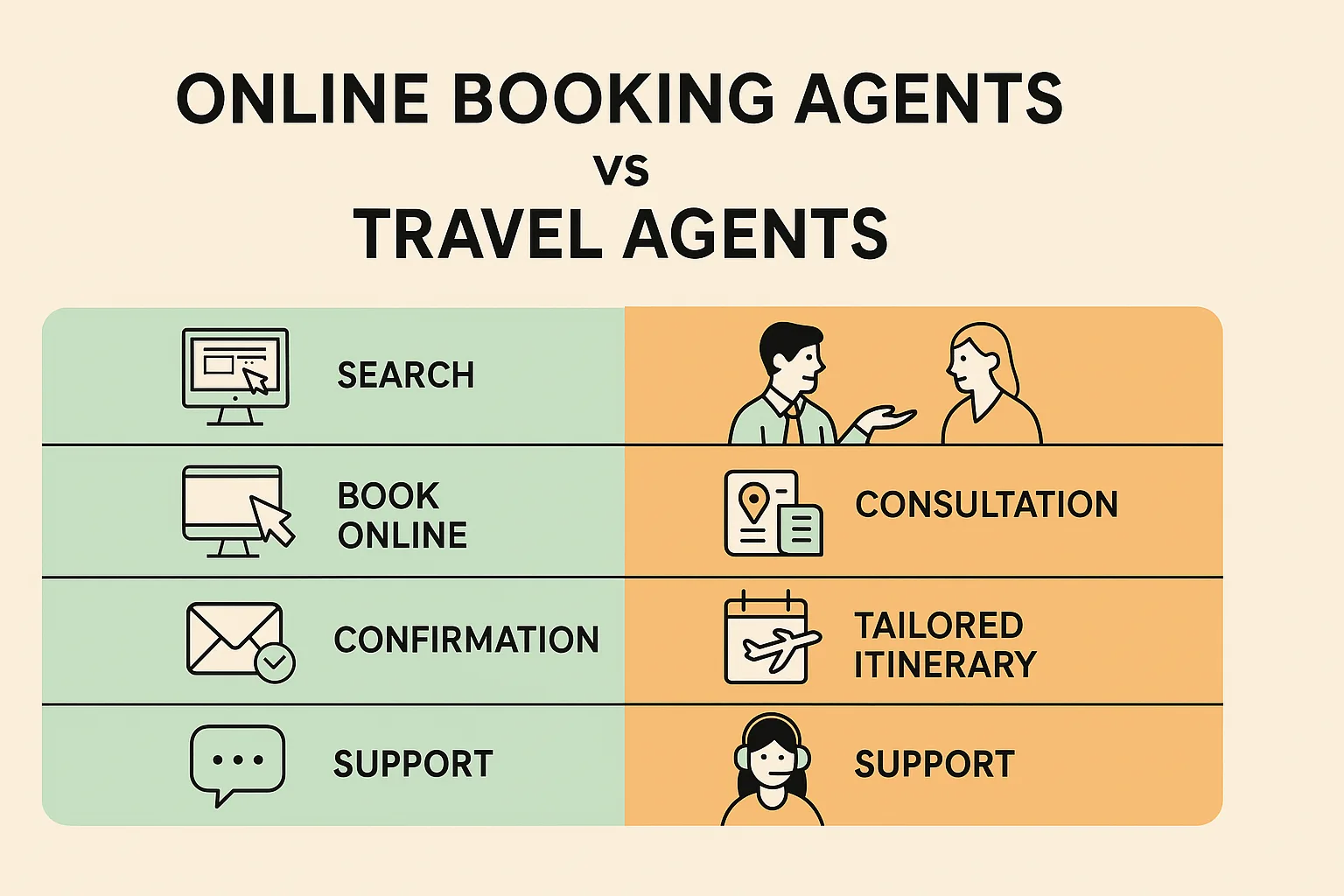Difference Between Online Booking Agents and Traditional Travel Agents
Introduction
As the tourism industry rapidly evolves with digital transformation, understanding the distinctions between Online Booking Agents (OBAs) and Traditional Travel Agents (TAs) is essential for hospitality professionals, tour operators, and destination managers.
What Are Online Booking Agents (OBAs)?
OBAs are digital platforms that allow travelers to search, compare, and book travel services entirely online. Examples:
- Booking.Com
- Expedia.Com
- PrivateTour.Com
- GetYourGuide.Com
What Are Traditional Travel Agents (TAs)?
Travel Agents operate through physical offices or via personal consultancy, providing tailored advice and human contact. Examples:
- AAA Travel
- Travel Leaders
- Luxury/niche planners
Key Differences
| Criteria | Online Booking Agents | Traditional Travel Agents |
|---|---|---|
| Booking Channel | Web/App-Based | In-person / Phone / Email |
| Availability | 24/7 Self-Service | Business Hours |
| Commission Model | High commission, fixed or dynamic | Negotiated fees or markups |
| Customer Interaction | Automated, low personalization | High-touch, personalized support |
| Best For | Simple, price-sensitive bookings | Complex, high-value travel |
| Tech Integration | Advanced (API, instant inventory) | Basic or manual systems |
Pros & Cons
✅ Online Booking Agents
- ✔ Global reach, instant access
- ✔ User reviews boost trust
- ✘ High commissions
- ✘ Less customer loyalty
✅ Traditional Travel Agents
- ✔ Personalized planning
- ✔ Ideal for group/luxury travel
- ✘ Slower process
- ✘ Limited reach
Strategic Advice for Tourism Businesses
- 🔹 Use OBAs for broad exposure
- 🔹 Work with TAs for high-ticket bookings
- 🔹 Strengthen direct booking channels
Trends to Watch: Hybrid Business Models & Direct Booking Solutions
As the travel technology landscape evolves, two trends are significantly reshaping how Travel Advisors select and work with their software partners: hybrid business models and direct booking capabilities.
Hybrid Models: Flexibility That Matches Your Workflow
Modern travel platforms are moving away from one-size-fits-all systems. Instead, many now offer hybrid models—solutions that let you combine different sales channels, tools, and workflows based on your business needs. These might include booking tools, CRM integrations, client portals, and white-label interfaces. Ask vendors how flexible their system is. Can you use it with your current tools? Does it integrate seamlessly with third-party platforms? Does it support both hosted and independent models?
This flexibility is essential, especially for agencies balancing B2B and B2C relationships, or those shifting between high-touch service and automated processes. A hybrid approach also enables more control over commissions, markups, and customer experience, giving advisors the power to design their own success blueprint.
Direct Booking: Speed Meets Profitability
Today’s clients expect instant options and seamless experiences. That’s why platforms with direct booking engines are increasingly valuable. Instead of relying solely on third-party marketplaces or GDS systems, direct booking allows you to offer real-time availability and pricing to your clients via your own site or client-facing portal. This means faster confirmations, better margins, and less friction.
Platforms like PrivateTour.com and Airbnb set the bar by empowering advisors with direct control over the booking process. During demos, ask whether the platform supports direct supplier connections, dynamic packaging, or instant booking functionality. These features can make a major impact on both the client experience and your bottom line.
In a world where personalization, responsiveness, and speed define customer loyalty, these two trends—hybrid adaptability and direct booking infrastructure—aren’t just nice-to-have. They’re essential. Make sure your next platform is ready to support them both.
Visual Example

Conclusion
Both Online Booking Agents (OBAs) and Traditional Travel Agents (TAs) offer unique strengths, and neither should be viewed as universally superior. OBAs deliver speed, scalability, and global reach—ideal for last-minute bookings, price-conscious travelers, and straightforward itineraries. In contrast, TAs offer a deeply personalized service model built on human expertise and trust, making them invaluable for high-touch travelers, complex journeys, and niche markets like luxury, group, or experiential travel.
For tourism businesses, the optimal strategy is rarely choosing one over the other. Instead, it lies in understanding how to integrate both channels into a cohesive distribution and sales approach. By leveraging OBAs for volume and visibility while nurturing relationships with TAs for high-margin, loyal clientele, operators can balance short-term revenue with long-term brand equity.
As consumer behavior shifts and technology advances, success in this competitive market will belong to those who can blend automation with personalization, digital efficiency with human connection. Aligning your channel strategy with both demand trends and operational goals will be key to sustaining growth in the future of travel.